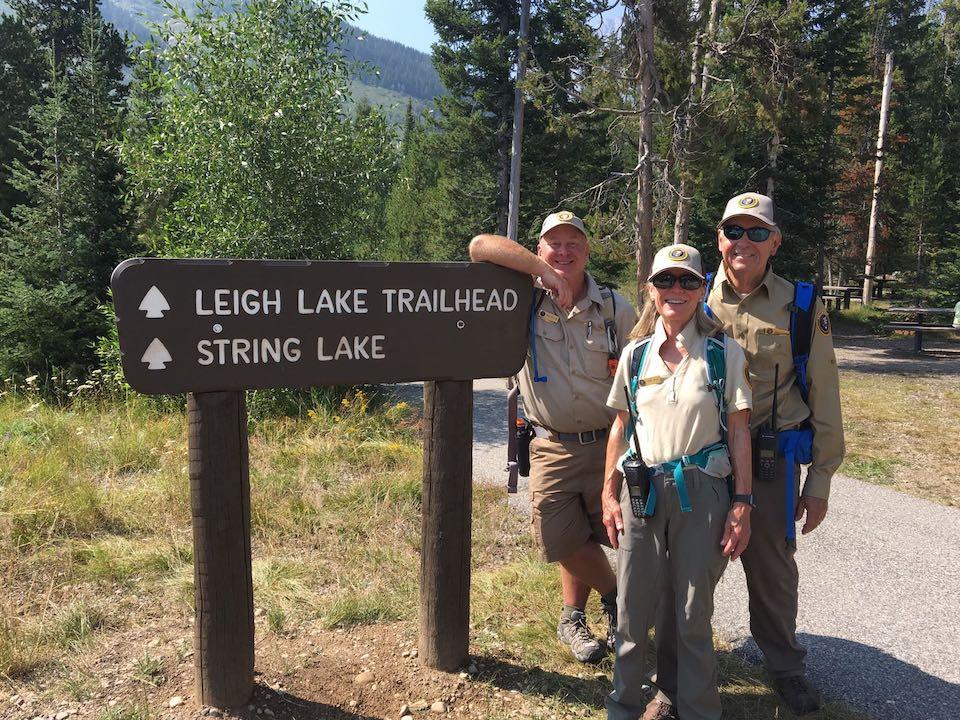
A volunteer group known as "String Lakers" works to protect natural resources, and visitors, at String Lake in Grand Teton National Park/GTNPF
Editor's note: While Grand Teton National Park is temporarily closed during the ongoing coronavirus pandemic, when it reopens this program will be back at work protecting natural resources and park visitors.
“The Grand Teton mountains have a sense of permanence, but the land and wildlife that surround them are fragile and subject to the pressures of human beings,” String Lake Volunteer Bob Weiss said. “I volunteer to help visitors understand that care is needed to preserve what we have now in the park, and ensure that going forward the beauty and strength that exists today is there in the future for others to enjoy.”
String Lake is a busy summertime destination in Grand Teton National Park because of its breathtaking views, access to water activities, and proximity to hiking trails. Last summer, researchers found that more than 4,000 people visited the area each day during the peak summer season. Near the parking lots, the lakeshore can become chaotic with hundreds of people and their picnic lunches. This is a challenging situation, as black bears and other wildlife also frequent String Lake. Leaving food unattended, even for a moment, can lead to a bear or other animal obtaining a food reward. Past human-black bear conflicts, primarily due to poor visitor food storage practices, have necessitated the removal, relocation, and euthanization of nuisance bears.
Grand Teton National Park is addressing this challenge with a unique solution for the successful management of this multiuse area. In 2016, a pilot volunteer program was implemented to attempt to minimize human-black bear conflicts and provide a uniformed, on-the-ground presence at String Lake. The mission of the volunteers is to provide an opportunity for a safe and enjoyable visitor experience while protecting the lakeshore and wildlife.
Comprised of approximately 30 individuals, the volunteers—called the Lakers—concentrate on bear and food storage education. Lakers actively patrol the shoreline, surrounding trails, picnic areas, parking lots, and backcountry campsites, securing unattended food and making contacts with visitors. Serving as educators and not enforcers, Laker visitor contacts exceeded 30,000 in 2018. Through this boots-on-the-ground interaction, volunteers increase visitors’ understanding of park rules; provide wayfinding, wildlife, and resource information; and significantly enhance visitor experiences.
Piloted in 2016 and 2017 and made permanent in 2018, the Laker program has been a resounding success. Grand Teton park management has used observational and scientific data collected by the team to increase safety, decrease congestion, and reduce resource damage. The park has already implemented several management tools based on the Lakers’ findings. These include parking delineators to channel traffic and protect pedestrians, increased messaging about proper food storage practices, barriers to protect sensitive wetland and riparian habitats, and more.
The Laker program is a model for low-cost management of high visitation, multiuse areas in the Greater Yellowstone Ecosystem—the Grand Teton National Park Foundation is proud to support this impactful effort.
“What we do is much more than just dealing with food storage violations,” String Lake Volunteer Bill Rietscha said. “We create special experiences for people that become lasting memories. And, sometimes they touch us in ways that opens our hearts and makes our spirits soar. Experiences like this are why I love being a Laker.”
Do you want to spend your summer in one of our country’s most popular parks? Volunteers are a critical component of everyday operations in Grand Teton National Park. Opportunities are available during the summer months in historic preservation, traffic management, bear education, trail construction, trail patrol, wildlife research, museum collections, visitor services and education, and much more!



Add comment